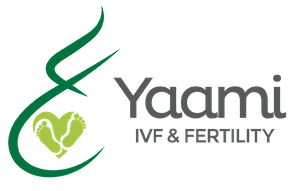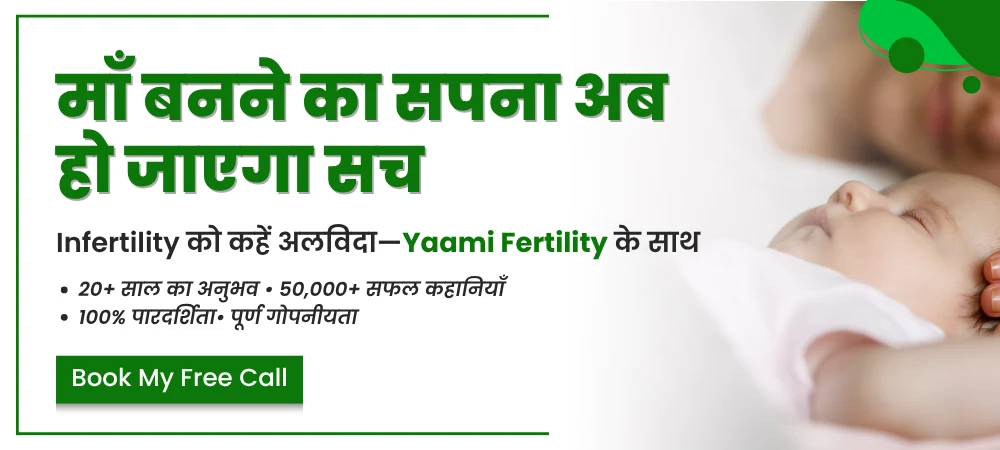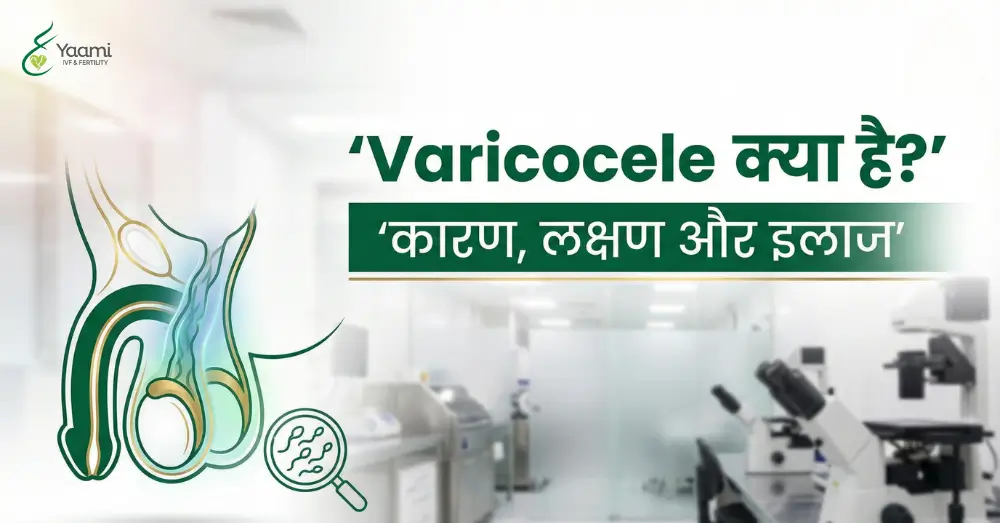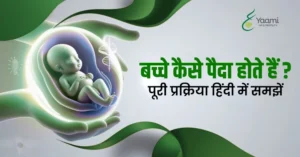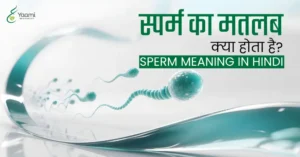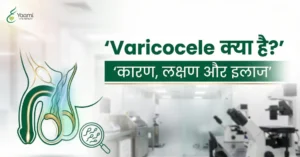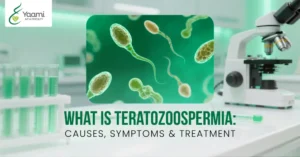Dreams are a part of everyone’s life. From a child wishing for a toy to a teenager fighting for success, every stage of life comes with its dream. One such beautiful dream for a married couple is to hold their little one in their arms, hear the first cry, and feel the tiny hand cling to theirs.
However, for some couples, this precious dream remains unfulfilled, leaving a void that can be deeply felt. They try everything with all their heart and still don’t succeed in bringing their dream to life.
Undeniably the reason behind this unfulfilled dream is infertility.
According to WHO research, worldwide, 1 in every 6 couples suffers from infertility issues. But, in the past few years, IVF and test tube babies have emerged as a new ray of hope for couples facing infertility issues such as blocked fallopian tubes, low sperm count, PCOS, recurrent miscarriages, etc.
Going forward, the question remains the same, What is Test Tube Baby (IVF), and how does it help couples to become parents?
Don’t worry, through this blog, we will dive deeper into what is test tube baby, the step-by-step process of IVF, and how one achieve the dream of parenthood through IVF.
Let’s explore what is test tube baby IVF, and walk through the step-by-step process.
The Step-by-Step Process of IVF (Test Tube Baby Procedure)
First of all, you will have to understand the fact that there is no difference between IVF and test tube baby. The term IVF is typically used in the medical sector while ‘test tube baby’ is a non-medical term used decades ago.
Most people think that ‘test tube babies’ are fully developed in the lab and are not as natural as any other baby. But this is not the truth.
IVF or test tube baby is a medical treatment designed to help couples who suffer from issues of natural conception due to some health problems such as blocked fallopian tubes, low sperm count, repeated miscarriages, etc.
This is not a one-day process but takes a similar or even longer time, than a natural pregnancy. Couples who are planning IVF or going through must keep patience throughout the entire journey because each step is crucial.
Let’s take a closer look at the steps involved in IVF.

1. Ovarian Stimulation
The very first of IVF is ovarian stimulation. Under this process, hormonal injections assist the ovaries in producing multiple eggs rather than a single egg, to increase the chances of pregnancy.
It involves fertility drugs (FSH & LH), regular checkups through ultrasounds, and a final hormone shot (HCG or Lupron) to prepare eggs for fertilization.
After the eggs are mature, doctors retrieve them for fertilization. The ovarian stimulation process is highly crucial for IVF as it enhances the success chances.
2. Egg Retrieval
After ovarian stimulation, the next important step is egg retrieval, which happens 24–36 hours later. Egg Retrieval is a minimally invasive procedure.
In this step, a thin needle is used to collect mature eggs carefully from the ovaries for embryo formation. If you’re worried about pain, there’s no need to stress—this process is done with light anesthesia to provide you with a pain-free experience and any discomfort.
The entire process is quick, it usually takes only 10–25 minutes. Once the eggs are collected, your progress will be tracked for a short time. Then you can go home after resting for about an hour.
3. Sperm Collection & Fertilization
After retrieving the eggs from the female body, the further process of fertilization requires the eggs of the males as well. The best and most motile sperm are selected with great care to enhance the possibility of successful fertilization.
Well, you must understand the fact that IVF is not solely focused on women. Similar to natural pregnancy the success of IVF depends on both males and females. If a man has issues with sperm count or quality, it can impact the chances of a successful outcome.
To address this, doctors carefully examine the male partner’s reproductive health, including sperm count, motility, and overall quality. If any issues are detected and the chances of fertilization seem low then donor sperm may be used to ensure successful fertilization and improve the chances of a healthy pregnancy.
Furthermore, chosen sperms are mixed with the retrieved eggs in the laboratory, bringing one step closer to developing embryos.
4. Embryo Development
This is the most important step in the IVF treatment cycle. Once the eggs and sperm are combined, the fertilized egg begins to develop into an embryo in an advanced laboratory setting. Throughout this process, experts carefully monitor its development and progress to make sure the embryo is growing as it should.
Doctors select the healthiest embryo or embryos to transfer into the woman’s uterus. In case, if couples are willing to have babies in the future, additional embryos can be preserved at a low temperature for future use, allowing them some freedom for when they desire to conceive once more.
5. Embryo Transfer
When the embryo is developed well and in the correct stage, the next step of IVF; Embryo Transfer begins. Embryo Transfer is a quick and painless procedure that doesn’t even require anesthesia. This process is done using a thin tube called a catheter.
After the completion of this process, the woman is advised to take proper rest and care for herself.
Around 15-16 days later, a pregnancy test is conducted to confirm if the implantation was successful and whether pregnancy has occurred or not.
6. Pregnancy Test
After 15-16 days following embryo transfer, a pregnancy test is recommended by the doctors to check the success of the procedure. This is generally carried out through a blood test (Beta hCG test), which helps to identify the pregnancy hormone in the body.
A positive test result shows that implantation has taken place successfully and the woman is pregnant. On the other hand, if the test shows a negative result then you should consult with the doctors about the next step.
This is the most emotional and long-awaited moment in the IVF process, as it shows whether the dream of the couple to become parents has been realized.
Success Rate of Test Tube Baby (IVF)
One of the most common doubts of couples is: What is the IVF success rate?
The answer might disappoint you but the fact is that the success rate of test tube baby / IVF is not definite as it keeps varying according to the couple. IVF’s success rate depends on several factors including the age of the patient, the quality of eggs and sperm, and the overall reproductive health of the couple.
The chances of a successful IVF pregnancy are usually higher in women under 35 years old, as the quality of eggs declines with age. Over time, as a person gets older, whether it’s male or female, the chance of success decreases.
IVF has assisted millions of couples globally though it should be noted that every case is different. Consulting with a fertility expert can give you a better idea about the possibility of success and what method is optimal for a positive result.
Myths & Facts About Test Tube Babies
There are countless myths and false beliefs associated with test tube babies or IVF such as babies born with IVF do not belong to the parents biologically, they are abnormal, only twins are born through IVF, etc.
Some people also think that they will never be able to conceive a second child naturally after IVF.
But the facts say something else.
Babies born with IVF are similar to those born naturally. IVF is just the way to eliminate complications or abnormalities of couples facing issues in achieving parenthood.
The only difference is that the fertilization takes place in a laboratory and then implantation in the uterus occurs.
The possibility of twins or triplets in IVF only arises when more than one embryo is implanted. Couples can plan their next child naturally or go for another IVF cycle.
Do not allow myths to hinder you from exploring the potential that IVF provides!

Cost of a Test Tube Baby in India
The price of IVF treatment depends on several factors such as the medical condition of the patient, the reason for infertility, whether he/she requires donor eggs or not, and most importantly the number of IVF cycles required to achieve parenthood.
Yet, at Yaami IVF Center, we make every effort to make fertility treatments affordable and accessible to couples aspiring to be parents. Our staff practices open pricing with no additional fees, offering quality services.
IVF is more than a medical procedure—it’s a beacon of hope for couples yearning to start a family. With advancements in fertility treatments and the right guidance, your dream of parenthood can become a reality.
Yaami Fertility Center is committed to providing expert guidance, emotional support, and top-notch care every step of the way. If you also dream of parenthood and need expert care and guidance, Yaami Fertility is available 24/7 to help you.

Dr. Sankalp Singh (MBBS, MS – Obstetrics & Gynecology, FIRM, FRM – Germany) is a highly respected Reproductive Medicine and IVF specialist with over 20 years of clinical experience. He is the founder and chief consultant at Yaami Fertility & IVF Center, Indore, where he provides advanced fertility solutions including IUI, IVF, ICSI, and fertility preservation. Trained internationally, Dr. Singh combines global expertise with a compassionate approach to guide couples on their journey to parenthood. He is also deeply committed to academic teaching, clinical research, and spreading awareness about reproductive health and fertility treatments.
